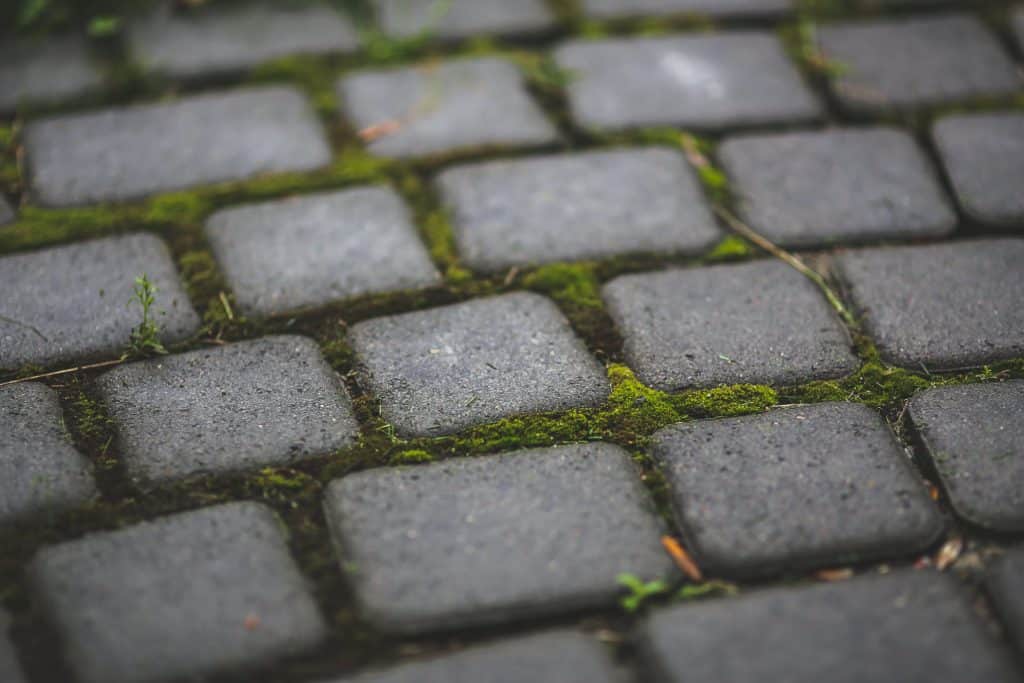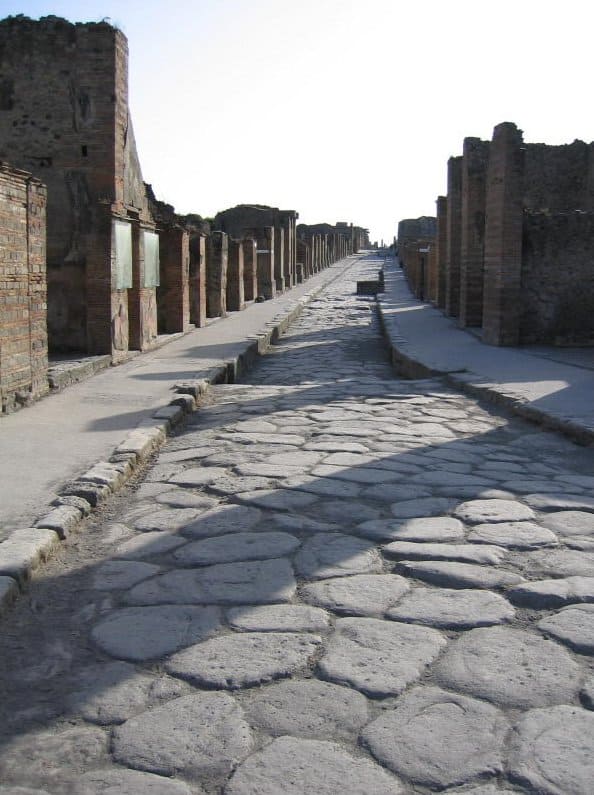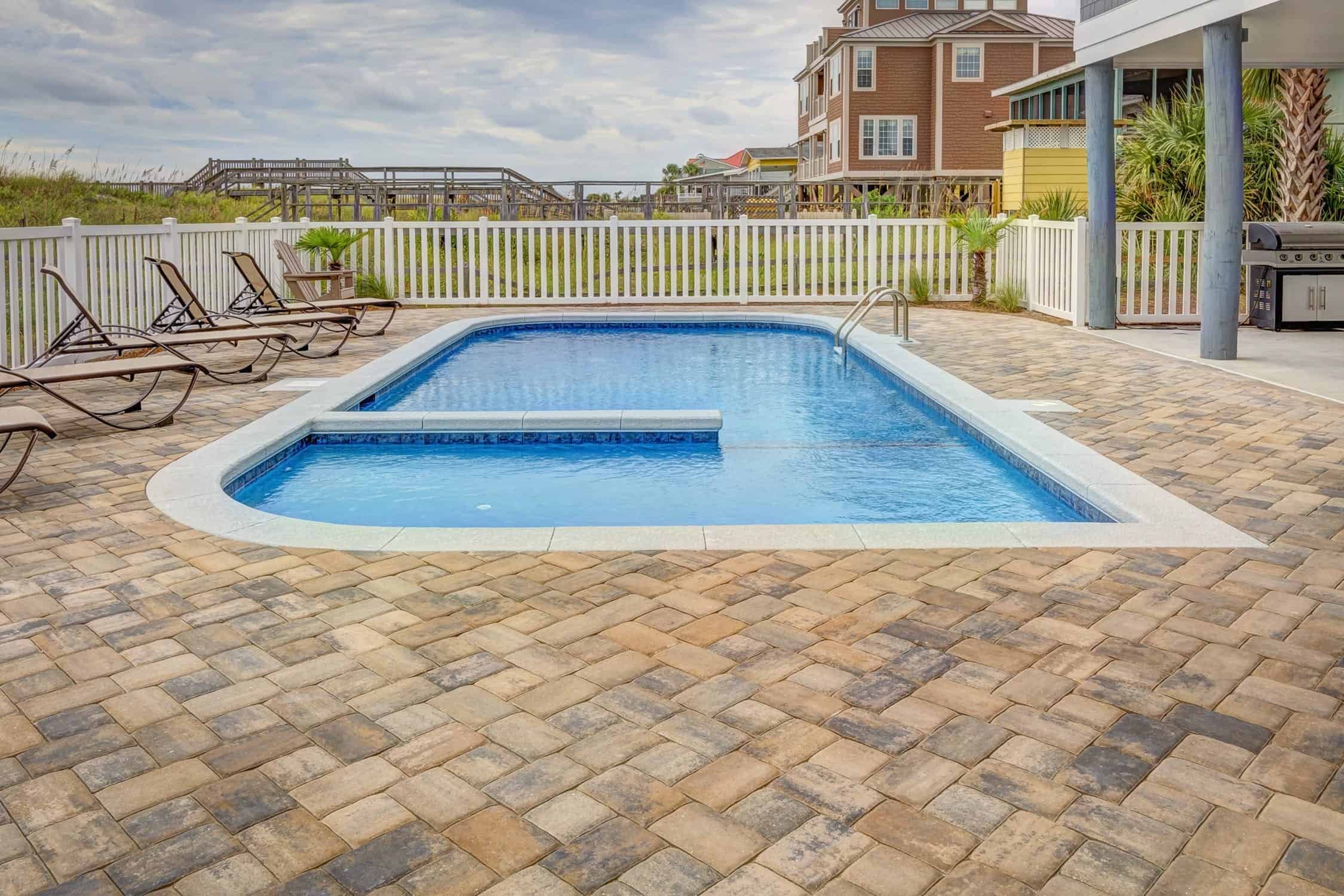In the patio world, stamped concrete vs. pavers is a question as old as patios themselves. Which one should you choose to craft your picturesque outdoor space? Most questions like these come down to raw personal preference, but there are some considerations you should make when deciding what material to build your patio from. Namely cost, durability, and maintenance.
Let’s dive right and start shedding some light on these questions.
What Is Stamped Concrete?
Stamped concrete is an innovative technique to turn simple poured concrete into ornate designs and patterns. Using a stamp, wet concrete forms to resemble most other construction materials (think back to your childhood playing with Play-Doh, stamped concrete works in much the same way). Depending on the skill of the contractor, the finished product can look just as good as more expensive options like flagstone, tile, and brick.
What Are Pavers?

Paving stones (or pavers for short) are factory-created clay, stone, concrete bricks used for construction. Using an industrial process, they are formed in a professional mold along with a coloring agent before being set to dry. Like stamped concrete, they fill a unique niche by being as ornate as other building materials while being far less expensive. Unlike stamped concrete, they arrive in bricks and must be installed one at a time.
How Much Does A Patio Made From Pavers Cost?
Unfortunately, this question is like asking how much a car costs. Construction materials and size will play a much larger part than simply whether it’s a paver or stamped concrete. For simplicity and normalization, I’m going to compare costs with a few assumptions. Our fictional patio is 12′ x 12′ large, uncovered, and on a level installation surface. Your outdoor space probably varies from this, but we’re only looking for relative cost.
You can expect to spend anywhere between between $2 and $15 per square foot for materials. Again, this depends on the material used. Whether you choose architectural slab or interlocking pavers will also make a difference. So, should you choose architectural slab or interlocking. For patios, you’ll often get by easily with simply going for the cheaper architectural slab. They’re thinner and less strong than interlocking pavers, but can work great on a budget (for patios — I would not use them driveways or any other surface that carried a large amount of weight).
Depending on your location, labor will add an additional $4 to $6 per square foot to the total cost. You can simply cross this off the cost if you decide to do it yourself. Let’s do some math:
12′ x 12′ = 144 square feet.
| Type | Low End | High End |
| With labor | $864 | $3,024 |
| DIY | $288 | $2,160 |
As you can see, doing it yourself will save a significant chunk of change!
How Much Does A Patio Constructed With Stamped Concrete Cost?
Stamped concrete is a completely different beast. Unless you’ve laid a lot of concrete in the past, the Captain would recommend you not try to do this yourself. Laying concrete is hard work and you have to know what you’re doing. Let me put this another way: do you really want to spend hours pouring concrete only to ruin it by messing up the stamp?
For basic designs, you can expect to pay anywhere from $8-$12 per square foot (labor included). The more intricate a stamped design becomes, the higher the price becomes. Likewise, as you add more colors, you also add more dollars per square foot. For simplicity’s sake, we’ll separate the costs into three distinct buckets. However, you should know that this is a gradient.
| Type | Price |
| Basic ($8/sqft) | $1,152 |
| Medium ($12/sqft) | $1,728 |
| High end ($18/sqft) | $2,592 |
So how should we read this data? Let’s dive in and try to figure out the economics of stamped concrete vs. pavers.
What Costs Less: Stamped Concrete or Pavers?
Generally, stamped concrete costs quite a bit less than pavers. “But Captain, look!” you say, as you look at the very cheap estimate of $288 for a low end DIY installation of pavers. I know, but there are two major caveats here! First, pavers are definitely more economical in three situations:
- You’re planning to do it yourself.
- You’re opting for the most basic, most budget options.
- You have a very small area to hardscape.
You see, the low-end of paver installation is a lot lower than stamped concrete. As you increase the quality of building materials, the cost quickly events out. Then, pavers will shoot way higher in price than their stamped cousins.
How Long Do Paver Patios Last?
Remember how it was incredibly cheap to install the most basic paver patio? Here comes the other caveat: the lifespan of a paver patio is almost entirely dependent upon the material used. The cheap, porous $2 per square foot pavers will have a lower up front cost. However, you’ll notice your patio deteriorating within the first few years unless you’re diligent about upkeep.
That being said, pavers are generally sturdier than stamped concrete, even when taking the cheap materials into consideration. When your patio starts deteriorating, you have some strong advantages with pavers:
- The paving stones are replaceable when they break or erode.
- Pavers are crafted under immense pressure in a factory. This ensures lasting durability/strength.
- Good quality pavers will actually strengthen as they settle.
So, how long do paver patios last? With proper upkeep and care, a good paver patio can be around for generations.
How Long Do Stamped Concrete Patios Last?
We established that paver lifespans are dependent upon the material being used. Stamped concrete patios have a similar dependency: if your contractor cuts corners or otherwise does a poor job installing it, you can suffer major issues down the road. One common fault introduced from poor craftsmanship is severe cracking of the concrete surface. Many sub-par contractors fail to ensure that the surface is stamped to a uniform depth.
Under ideal conditions with competent contractors and regular upkeep, you can expect a stamped concrete patio to last at least 25 years (and potentially more).
What Lasts Longer: Stamped Concrete or Pavers?
With the same level of maintenance and care, you can expect pavers to outlast stamped concrete by many, many years. Let’s be real — some Roman roads are still in existence today. Now, your patio probably won’t be around in a thousand years, but if you construct it from pavers it will be built in a similar fashion.

We have to clearly say that a patio built from pavers will definitely last longer than a patio built from stamped concrete.
Steps To Maintain A Paver Patio
A patio built with pavers is going to be a lot less hands-on than it’s stamped concrete counterpart. Realistically, there are only two you have to do:
- Keep plants from growing from the cracks between the paver stones (if you currently have this problem, check out our guide on eliminating weeds from your patio).
- Fill the cracks between the stones with polymeric sand. This sand hardens when moistened, holding the bricks into place while also preventing weeds from growing.
If you’d like a gold medal in patio ownership, you can add regular sweeping and sealing the pavers every four or five years to that list. Oh, and one last thing: do not salt your patio. Salting your patio will all but ensure it corrodes.
Steps to Maintain A Stamped Concrete Patio
A stamped concrete patio is slightly more involved to maintain. You won’t have to worry about any weeds growing through the concrete (unless it cracks, which is a whole other can of worms). However, you have to be diligent with upkeep or the patio’s lifespan will decrease immensely. What kind of upkeep can you expect?
- You’ll want to clean it regularly with a garden hose and at least once per year with a pressure washer.
- You’ll need to apply sealer to the surface every few years (or sooner if you notice that the painted concrete is starting to fade or dull).
- I’ll repeat this point: avoid salting your patio. Just don’t do it. Buy a snow shovel and get to work.
- Make sure no large plants grow around the stamped concrete. Roots can push the earth upward, causing the concrete to crack.
This is an entirely manageable list. But if you’re the type of person who regularly lets things fall to the wayside, you might rethink the stamped concrete option. You have to care for it.
What Is Easier To Maintain: Stamped Concrete or Pavers?
Pavers are ultimately easier to maintain than stamped concrete. Not only can you be less diligent about upkeep, but you can simply replace single paver stones as they erode / break. The only way to “fix” cracked concrete is by pouring more concrete.
The Verdict
It may sound like I’m leaning toward pavers because of their many pros. Not only are they easier to maintain, but it’s likely that they’ll last way longer than stamped concrete. However, at the end of the day you have to make your own cost-benefit analysis about which will be better for you long term.
Reasons You Might Lean Toward Pavers
- You’re sure you’ll be in the house you’re in for another 40 years.
- You’re a DIY kind of person and want to build the patio yourself.
- You want a low-maintenance patio arrangement.
- You have the disposable income and simply like pavers better.
Reasons You Might Lean Toward Stamped Concrete
- You’re pretty sure you’ll only be in your current house for 5 years or less.
- You want the most bang for your buck.
- You want a custom, intricate stamp that pavers can’t replicate.
After all of that, I can really only say “it depends.”

